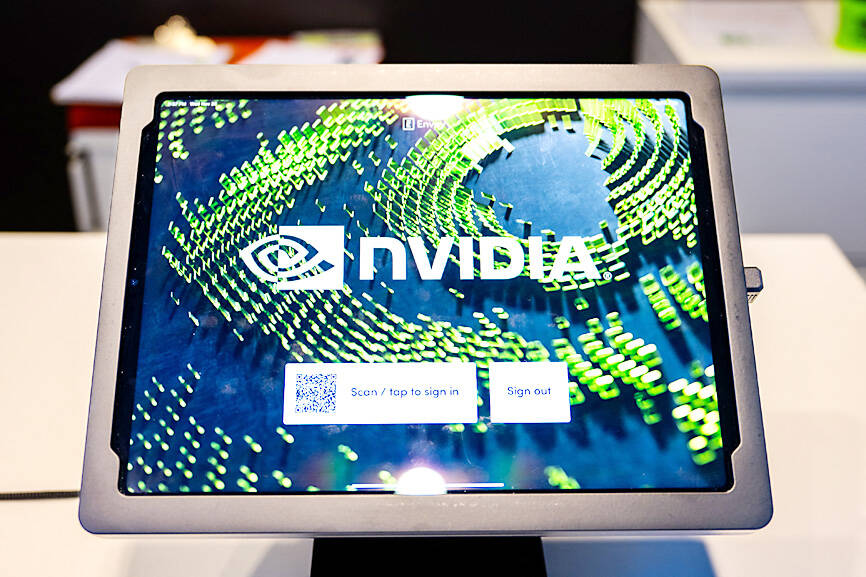Nvidia Corp on Wednesday reported a surge in third-quarter profit and sales as demand for its specialized computer chips that power artificial intelligence (AI) systems remains robust.
For the three months that ended on Oct. 27, the tech giant based in Santa Clara, California, posted revenue of US$35.08 billion, up 94 percent from US$18.12 billion a year ago.
Nvidia said it earned US$19.31 billion in the quarter, more than double the US$9.24 billion it posted in last year’s third quarter. Adjusted for one-time items, it earned US$0.81 a share.

Photo: Brandon Bell / GETTY IMAGES NORTH AMERICA / Getty Images via AFP)
Wall Street analysts had been expecting adjusted earnings of US$0.75 a share on revenue of US$33.17 billion, according to FactSet.
However, investors took the results in stride, and Nvidia’s high-flying stock slipped 2.5 percent in after-hours trading. Shares in Nvidia are up 195 percent so far this year.
Nvidia said it expects fourth-quarter revenue to grow to US$37.5 billion, plus or minus 2 percent. Analysts are expecting, on average, US$37.09 billion.
“The age of AI is in full steam, propelling a global shift to Nvidia computing,” Nvidia founder and CEO Jensen Huang (黃仁勳) said in a statement.
Nvidia’s third-quarter data center revenue was US$30.8 billion, up 112 percent from a year earlier. That growth was driven by demand for the Hopper computing platform for large language models, recommendation engines and generative AI applications, the company said.
Analysts were eyeing Nvidia’s guidance on its Blackwell graphics processor unit, a next-generation AI chip that has seen demand from companies like OpenAI and others building AI data centers.
Nvidia chief financial officer Colette Kress said Blackwell production shipments are scheduled to begin in the fourth quarter of the next fiscal year and would continue to ramp into fiscal 2026.
On an earnings call on Wednesday, Kress told investors that both Hopper and Blackwell systems “have certain supply constraints, and the demand for Blackwell is expected to exceed supply for several quarters in fiscal 2026.”
“Every customer is racing to be the first to market,” Kress said. “Blackwell is now in the hands of all of our major partners, and they are working to bring up their data centers.”
The company, seen as a bellwether for AI demand, would deliver “more Blackwells than we had previously estimated” this quarter, Huang added.
Nvidia’s fourth-quarter guidance was “a little bit disappointing,” said David Volpe, senior fund manager at Emerald Insights Fund, but the company still had “a tremendous quarter.”
“There’s nothing touching it in terms of the growth,” Volpe said.
Demand for generative AI products that can compose documents, make images and serve as personal assistants has fueled sales of Nvidia’s specialized chips over the last year. Nvidia, the most valuable publicly traded company by market cap as of the close of trading on Wednesday, is now worth over US$3.579 trillion, with analysts closely monitoring Nvidia’s path to US$4 trillion.
Wedbush Securities Inc analyst Dan Ives said the earnings report shows “the AI Revolution is still in the early innings of playing out.”
“We view this as a Nvidia earnings press release that should be hung in the Louvre,” Ives said. “Blackwell demand is just beginning. Any sell-off [in Nvidia’s stock] we would view as short-lived, with our view this is a US$4 trillion market cap in 2025 as the Godfather of AI Jensen [Huang] drives this spending wave.”
Through the year’s first six months, Nvidia’s stock soared nearly 150 percent. At that point, the stock was trading at a little more than 100 times the company’s earnings over the prior 12 months. That is much more expensive than it has been historically and more than the S&P 500 in general.
“The age of AI is upon us,” Huang said on the call. “And it’s large and diverse.”

JITTERS: Nexperia has a 20 percent market share for chips powering simpler features such as window controls, and changing supply chains could take years European carmakers are looking into ways to scratch components made with parts from China, spooked by deepening geopolitical spats playing out through chipmaker Nexperia BV and Beijing’s export controls on rare earths. To protect operations from trade ructions, several automakers are pushing major suppliers to find permanent alternatives to Chinese semiconductors, people familiar with the matter said. The industry is considering broader changes to its supply chain to adapt to shifting geopolitics, Europe’s main suppliers lobby CLEPA head Matthias Zink said. “We had some indications already — questions like: ‘How can you supply me without this dependency on China?’” Zink, who also

At least US$50 million for the freedom of an Emirati sheikh: That is the king’s ransom paid two weeks ago to militants linked to al-Qaeda who are pushing to topple the Malian government and impose Islamic law. Alongside a crippling fuel blockade, the Group for the Support of Islam and Muslims (JNIM) has made kidnapping wealthy foreigners for a ransom a pillar of its strategy of “economic jihad.” Its goal: Oust the junta, which has struggled to contain Mali’s decade-long insurgency since taking power following back-to-back coups in 2020 and 2021, by scaring away investors and paralyzing the west African country’s economy.

BUST FEARS: While a KMT legislator asked if an AI bubble could affect Taiwan, the DGBAS minister said the sector appears on track to continue growing The local property market has cooled down moderately following a series of credit control measures designed to contain speculation, the central bank said yesterday, while remaining tight-lipped about potential rule relaxations. Lawmakers in a meeting of the legislature’s Finance Committee voiced concerns to central bank officials that the credit control measures have adversely affected the government’s tax income and small and medium-sized property developers, with limited positive effects. Housing prices have been climbing since 2016, even when the central bank imposed its first set of control measures in 2020, Chinese Nationalist Party (KMT) Legislator Lo Ting-wei (羅廷瑋) said. “Since the second half of

AI BOOST: Next year, the cloud and networking product business is expected to remain a key revenue pillar for the company, Hon Hai chairman Young Liu said Manufacturing giant Hon Hai Precision Industry Co (鴻海精密) yesterday posted its best third-quarter profit in the company’s history, backed by strong demand for artificial intelligence (AI) servers. Net profit expanded 17 percent annually to NT$57.67 billion (US$1.86 billion) from NT$44.36 billion, the company said. On a quarterly basis, net profit soared 30 percent from NT$44.36 billion, it said. Hon Hai, which is Apple Inc’s primary iPhone assembler and makes servers powered by Nvidia Corp’s AI accelerators, said earnings per share expanded to NT$4.15 from NT$3.55 a year earlier and NT$3.19 in the second quarter. Gross margin improved to 6.35 percent,